Yamaha FC1800A-R, FC1800-R Manual

2016 WaveRunner
FX SVHO
FX Cruiser SVHO
OWNER’S/OPERATOR’S MANUAL
 Read this manual carefully
Read this manual carefully
before operating this watercraft.
F3J-F8199-73-E0
Read this manual carefully before operating this watercraft. This manual should stay with the WaveRunner if it is sold.
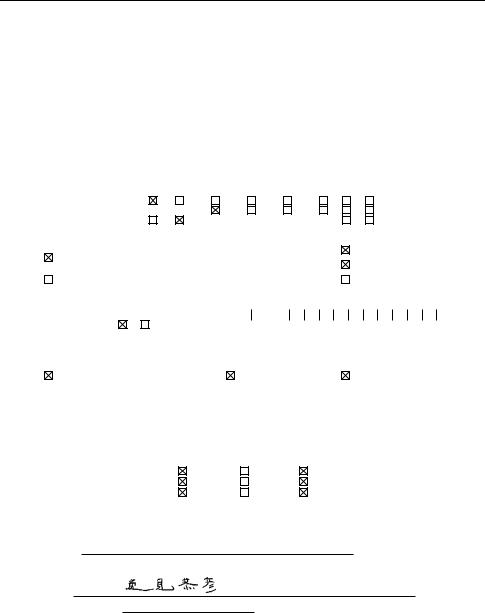
Important manual information
EJU42733
Declaration of Conformity for Personal Watercraft (PWC)
with the requirements of Directive 94/25/EC, as amended by Directive 2003/44/EC
Name of PWC Manufacturer: |
|
YAMAHA MOTOR CO., LTD. |
|
|
|
|
|
|
|
|||||||||
Address: 2500 Shingai, Iwata, Shizuoka 438-8501, Japan |
|
|
|
|
|
|
|
|
|
|
||||||||
|
|
|
|
|
|
|
|
|
|
|
|
|
||||||
Name of Authorised Representative: YAMAHA MOTOR EUROPE N.V. |
|
|
|
|
|
|||||||||||||
|
|
|
|
|
|
|
|
|
|
|
|
|
||||||
Address: Koolhovenlaan 101, 1119 NC Schiphol-Rijk, The Netherlands |
|
|
|
|
|
|||||||||||||
|
|
|
|
|
|
|
|
|
|
|
|
|||||||
Name of Notified Body for exhaust and noise emission assessment: SNCH |
|
|
ID Number: 0499 |
|||||||||||||||
|
|
|
|
|
|
|
|
|
|
|
||||||||
Address: 11, route de Luxembourg BP 32, Sandweiler, L-5230. Luxembourg |
|
|
|
|
|
|||||||||||||
|
|
|
|
|
|
|
|
|
|
|
|
|
|
|
||||
Conformity assessment module used: |
|
|
|
|
|
|
|
|
|
|
|
|
||||||
for construction: |
A |
Aa |
B+C |
B+D |
B+E |
B+F |
G |
H |
||||||||||
for exhaust emissions: |
|
|
B+C |
B+D |
B+E |
B+F |
G |
H |
||||||||||
for noise emissions: |
A |
Aa |
|
|
|
|
|
|
|
|
G |
H |
||||||
Other Community Directives applied |
|
|
|
|
|
|
|
|
Standards |
|||||||||
|
|
|
|
|
|
|
|
|
|
|
|
|
|
|
|
|
||
|
Electromagnetic Compatibility Directive 2004/108/EC and 2014/30/EU |
|
|
EN 55012:2007/A1:2009 |
||||||||||||||
|
|
|
|
|
|
|||||||||||||
|
|
EN 61000-6-2:2005 |
||||||||||||||||
|
|
|
|
|
|
|
|
|
|
|
|
|
|
|
|
|||
|
|
|
|
|
|
|
|
|
|
|
|
|
|
|||||
|
Directive 2006/42/EC relating to Machinery. |
|
|
|
|
|
|
|
|
|
|
|
|
|||||
|
|
|
|
|
|
|
|
|
|
|
|
|
|
|
|
|
||
|
|
|
|
|
|
|
|
|
|
|
|
|
|
|
|
|
|
|
DESCRIPTION OF CRAFT |
|
|
|
|
|
|
|
|
|
|
|
|
|
|
|
|||
|
|
|
|
|
|
|
|
|||||||||||
Craft model Identification Number, starting from : |
U |
S |
- |
Y |
A M A |
0 |
0 0 1 F 5 1 6 |
|||||||||||
Design Category : C |
D |
|
|
|
|
|
|
|
||
Model name / Commercial name : FC1800A-R / FX Cruiser SVHO, FC1800-R / FX SVHO |
||||||||||
DESCRIPTION OF ENGINE |
|
|
|
|
|
|
|
|||
Engine Type: |
|
|
|
Fuel Type: |
|
|
Combustion cycle: |
|||
|
|
|
|
|
|
|
|
|
|
|
|
PWC engine |
|
|
|
|
Petrol |
|
|
|
4 stroke |
|
|
|
|
|
|
|
|
|
|
|
|
IDENTIFICATION OF ENGINE COVERED BY THIS DECLARATION OF CONFORMITY |
|||||||||
Name of engine model |
EC Type–examination certificate number |
Name / ID number of Notified Body |
||||||||
|
|
|
|
|
|
|
||||
6ET |
SNCH*94/25*2003/44*0076 |
|
SNCH / 0499 |
|||||||
ESSENTIAL REQUIREMENTS |
|
|
|
|
|
|
|
|||
Essential requirements |
|
standards |
|
other normative |
technical file |
Please specify in more detail |
||||
|
document / method |
(* = mandatory standard) |
||||||||
|
|
|
|
|
|
|||||
|
|
|
|
|
|
|
|
|
||
I.A design and construction |
|
|
|
|
|
|
|
EN ISO 13590 |
||
I.B exhaust emission |
|
* |
|
|
|
|
|
*EN ISO 8178-1 |
||
I.C noise emission |
|
* |
|
|
|
|
|
*EN ISO 14509 |
||
|
|
|
|
|
|
|
|
|
|
|
This declaration of conformity is issued under the sole responsibility of the manufacturer. I declare on behalf of the PWC manufacturer that the craft model(s) and engine(s) mentioned above complies (comply) with all applicable essential requirements in the way specified and is (are) in conformity with the type(s) for which above mentioned EC type-examination certificate(s) has (have) been issued.
Name / Title: Y. Henmi / General Manager of Engineering Section, Boat Business Unit
(identification of the person empowered to sign on behalf of the manufacturer)
Signature:
(or an equivalent marking)
Date and place of issue: 1st / June / 2015, Shizuoka, Japan
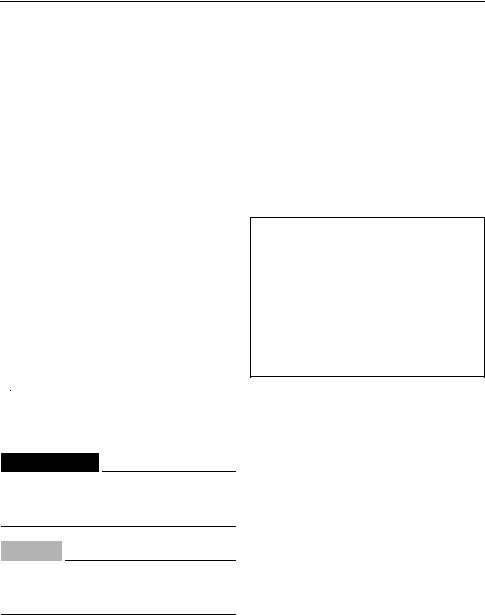
Important manual information
EJU30193
To the owner/operator
Thank you for choosing a Yamaha watercraft. This owner’s/operator’s manual contains information you will need for proper operation, maintenance, and care. If you have any questions about the operation or maintenance of your watercraft, please consult a Yamaha dealer.
This manual is not a course on boating safety or seamanship. If this is your first watercraft, or if you are changing to a type of watercraft you are not familiar with, for your own comfort and safety, please ensure that you obtain proper training or practice before operating the watercraft by yourself. In addition, a Yamaha dealer or boating organization will be pleased to recommend local sea schools, or competent instructors.
In this manual, information of particular importance is distinguished in the following ways:
 This is the safety alert symbol. It is used to alert you to potential personal injury hazards. Obey all safety messages that follow this symbol to avoid possible injury or death.
This is the safety alert symbol. It is used to alert you to potential personal injury hazards. Obey all safety messages that follow this symbol to avoid possible injury or death.
EWJ00072
 WARNING
WARNING
A WARNING indicates a hazardous situation which, if not avoided, could result in death or serious injury.
ECJ00092
NOTICE
A NOTICE indicates special precautions that must be taken to avoid damage to the watercraft or other property.
TIP:
EJU40411
Because Yamaha has a policy of continuing product improvement, this product may not be exactly as described in this owner’s/operator’s manual. Specifications are subject to change without notice.
This manual should be considered a permanent part of this watercraft and should remain with it even if the watercraft is subsequently sold.
EJU30233
WaveRunner FX SVHO / FX Cruiser
SVHO
OWNER’S/OPERATOR’S MANUAL ©2015 by Yamaha Motor Co., Ltd.
1st Edition, September 2015 All rights reserved.
Any reprinting or unauthorized use without the written permission of Yamaha Motor Co., Ltd.
is expressly prohibited. Printed in U.S.A.
A TIP provides key information to make procedures easier or clearer.

Table of contents
General and important labels........... |
1 |
Identification numbers .................... |
1 |
Primary Identification (PRI-ID) |
|
number............................................ |
1 |
Craft Identification Number (CIN)....... |
1 |
Engine serial number.......................... |
1 |
Manufactured date label .................... |
2 |
Model information ........................... |
2 |
Builder’s plate .................................... |
2 |
Important labels .............................. |
4 |
Warning labels.................................... |
5 |
Other labels ........................................ |
9 |
Safety information........................... |
11 |
Limitations on who may operate |
|
the watercraft ............................. |
11 |
Cruising limitations........................ |
12 |
Operation requirements ................ |
13 |
Recommended equipment ........... |
15 |
Hazard information........................ |
16 |
Watercraft characteristics ............. |
16 |
Wakeboarding and water-skiing ... |
18 |
Safe boating rules ......................... |
19 |
Enjoy your watercraft |
|
responsibly................................. |
20 |
Description....................................... |
21 |
Watercraft glossary ....................... |
21 |
Location of main components ...... |
22 |
Control function operation ............. |
26 |
Watercraft control functions ......... |
26 |
Remote control transmitter .............. |
26 |
Yamaha Security System ................. |
27 |
Engine stop switch .......................... |
28 |
Engine shut-off switch .................... |
28 |
Start switch ..................................... |
28 |
Throttle lever .................................... |
29 |
RiDE lever......................................... |
29 |
Steering system ............................... |
29 |
Adjustable tilt steering system ......... |
30 |
Cooling water pilot outlets ............... |
31 |
Water separator................................ |
31 |
Watercraft operation ...................... |
32 |
Watercraft operation functions ..... |
32 |
Shift system...................................... |
32 |
Electric trim system.......................... |
34 |
Watercraft operation modes......... |
36 |
Low RPM Mode ............................... |
36 |
No-wake mode................................. |
37 |
Cruise assist..................................... |
38 |
Instrument operation...................... |
40 |
Multifunction information center... |
40 |
Analog speedometer/tachometer..... |
40 |
Information display........................... |
41 |
Multifunction display ........................ |
45 |
Equipment operation ...................... |
50 |
Equipment..................................... |
50 |
Seats ................................................ |
50 |
Handgrip........................................... |
51 |
Reboarding grip................................ |
51 |
Reboarding step............................... |
51 |
Bow eye............................................ |
52 |
Stern eyes ........................................ |
52 |
Cleat ................................................. |
52 |
Pull-up cleats (FX Cruiser SVHO) ..... |
53 |
Storage compartments .................... |
53 |
Fire extinguisher holder and cover... |
58 |
Operation and handling |
|
requirements ................................... |
59 |
Fuel requirements ......................... |
59 |
Fuel................................................... |
59 |
Engine oil requirements ................ |
61 |
Engine oil.......................................... |
61 |
Draining the bilge water................ |
63 |
Draining the bilge water on land....... |
63 |
Draining the bilge water on water .... |
63 |

Table of contents
Transporting on a trailer................ |
64 |
First-time operation ........................ |
65 |
Engine break-in ............................. |
65 |
Pre-operation checks ..................... |
66 |
Pre-operation checklist .................... |
66 |
Pre-operation check points........... |
68 |
Pre-launch checks ........................... |
68 |
Post-launch checks ......................... |
74 |
Operation ......................................... |
77 |
Operating your watercraft ............. |
77 |
Getting to know your watercraft ...... |
77 |
Learning to operate your |
|
watercraft...................................... |
77 |
Riding position ................................. |
78 |
Launching the watercraft ................. |
78 |
Starting the engine on water ............ |
78 |
Stopping the engine ......................... |
79 |
Leaving the watercraft...................... |
79 |
Operating the watercraft .................. |
79 |
Turning the watercraft ...................... |
80 |
Stopping the watercraft ................... |
81 |
Operating the watercraft in reverse |
|
or neutral....................................... |
82 |
Boarding the watercraft ................... |
83 |
Starting off........................................ |
85 |
Capsized watercraft ......................... |
86 |
Beaching and docking the |
|
watercraft...................................... |
87 |
Operating in weeded areas .............. |
87 |
After removing the watercraft from |
|
the water ....................................... |
88 |
Care and storage............................. |
89 |
Post-operation care ...................... |
89 |
Flushing the cooling water |
|
passages....................................... |
89 |
Cleaning the watercraft .................... |
90 |
Battery care...................................... |
90 |
Long-term storage ........................ |
93 |
Rustproofing..................................... |
93 |
Maintenance.................................... |
94 |
Maintenance ................................. |
94 |
Tool kit.............................................. |
94 |
Removing and installing the engine |
|
cover ............................................. |
94 |
Periodic maintenance chart ............. |
96 |
Engine oil and oil filter ...................... |
98 |
Specifications.................................. |
99 |
Specifications ............................... |
99 |
Trouble recovery ........................... |
100 |
Troubleshooting.......................... |
100 |
Troubleshooting chart .................... |
100 |
Emergency procedures .............. |
103 |
Cleaning the jet intake and |
|
impeller ....................................... |
103 |
Raising the reverse gate................. |
104 |
Jumping the battery ....................... |
104 |
Replacing the fuses........................ |
105 |
Towing the watercraft..................... |
107 |
Submerged watercraft ................... |
107 |
Index............................................... |
109 |
Cleaning ........................................... |
93 |
Lubrication ....................................... |
93 |
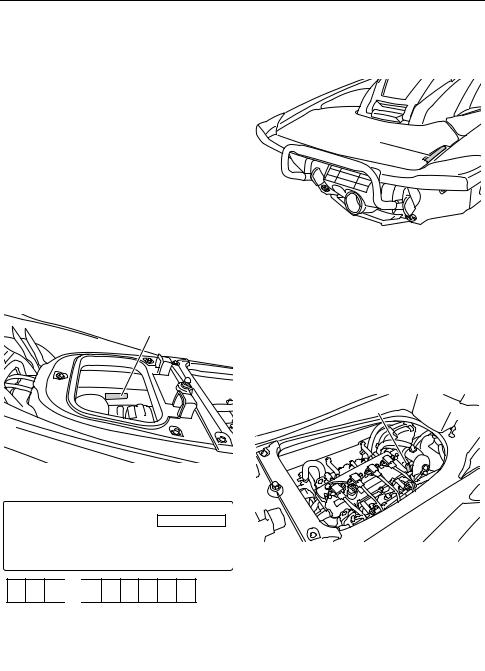
General and important labels
EJU36452
Identification numbers
Record the Primary Identification (PRI-ID) number, Craft Identification Number (CIN), and engine serial number in the spaces provided for assistance when ordering spare parts from a Yamaha dealer. Also record and keep these ID numbers in a separate place in case your watercraft is stolen.
EJU42521
Primary Identification (PRI-ID) number
The PRI-ID number is stamped on a plate attached inside the engine compartment. (See page 50 for seat removal and installation procedures and page 56 for information on the removable watertight storage compartment.)
MODEL:
FC1800-R (FX SVHO) FC1800A-R (FX Cruiser SVHO)
1
1Primary Identification (PRI-ID) number location
|
|
PRI-I.D. |
MODEL |
|
F3J |
YAMAHA MOTOR CO., LTD.
ASSEMBLED IN U.S.A. FROM AMERICAN AND JAPANESE COMPONENTS.
ASSEMBLÉ AUX ÉTATS-UNIS DE PIÈCES AMÉRICAINES ET JAPONAISES.
F 3 J 


EJU36551
Craft Identification Number (CIN)
The CIN is stamped on a plate attached to the aft deck.
1
1 Craft Identification Number (CIN) location
EJU40471
Engine serial number
The engine serial number is stamped on a plate attached to the engine unit. (See page 50 for seat removal and installation procedures and page 94 for engine cover removal and installation procedures.)
1

1 Engine serial number location
1
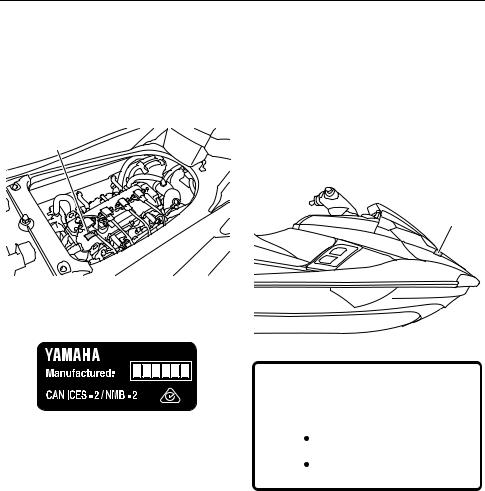
General and important labels
EJU42031
Manufactured date label
This label is attached to the top of the cylinder head. (See page 50 for seat removal and installation procedures and page 94 for engine cover removal and installation procedures.)
1
1 Manufactured date label location
EJU30321
Model information
EJU30332
Builder’s plate
Watercraft with this label conform to certain portions of the European Parliament directive relating to machinery.
Part of the information is given on the builder’s plate affixed on the craft. A full explanation of this information is given in the relevant sections of this manual.
1
1 Builder’s plate location
YAMAHA MOTOR CO., LTD.
2500 Shingai, Iwata, Shizuoka, Japan
WATERCRAFT DESIGN CATEGORY : C MAXIMUM CAPACITIES
Max.  3
3 
 Max.
Max.  +
+  = 240kg (530 lbs)
= 240kg (530 lbs)
Design category of this personal watercraft: C
Category C:
This watercraft is designed to operate in winds up to Beaufort force 6 and the associated wave heights (significant wave heights up to 2 m (6.56 ft); see the following TIP). Such conditions may be encountered in exposed inland waters, in estuaries, and in coastal waters in moderate weather conditions.
2

General and important labels
TIP:
The significant wave height is the mean height of the highest one-third of the waves, which approximately corresponds to the wave height estimated by an experienced observer. However, some waves will be double this height.
3
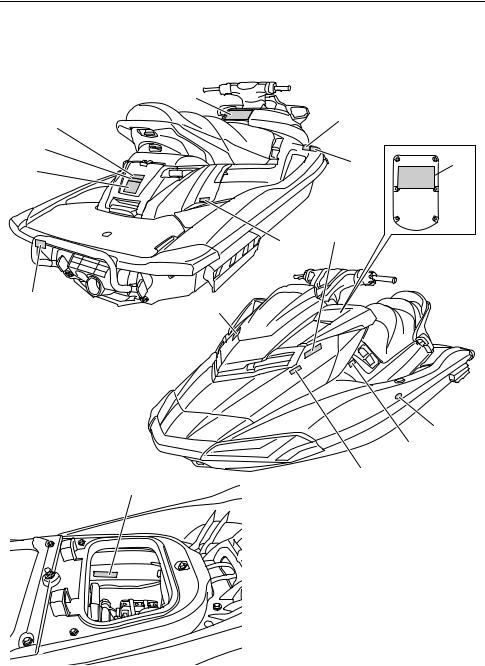
General and important labels
EJU30453
Important labels
Read the following labels before using this watercraft. If have any questions, consult a Yamaha dealer.
|
|
1 |
|
|
6 |
13 |
|
|
|
|
|
7 |
|
5 |
|
11 |
|
15 |
|
|
|
|
|
|
|
10 |
|
|
|
3 |
|
14 |
|
2 |
|
|
|
|
12
4
9
8
4
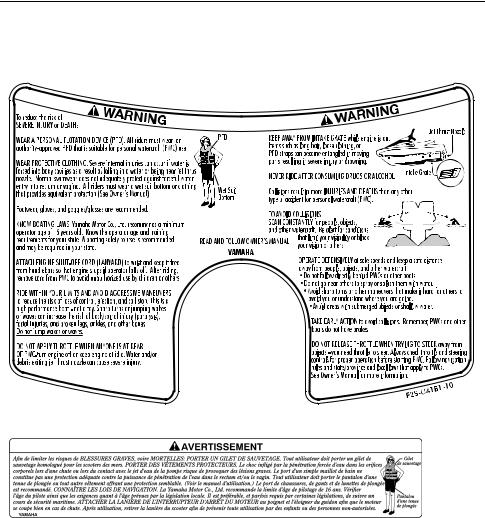
General and important labels
EJU35914
Warning labels
If any of these labels are damaged or missing, contact a Yamaha dealer for replacements.
1
2
F1B-U41B1-21
F2S-U41B1-20
5
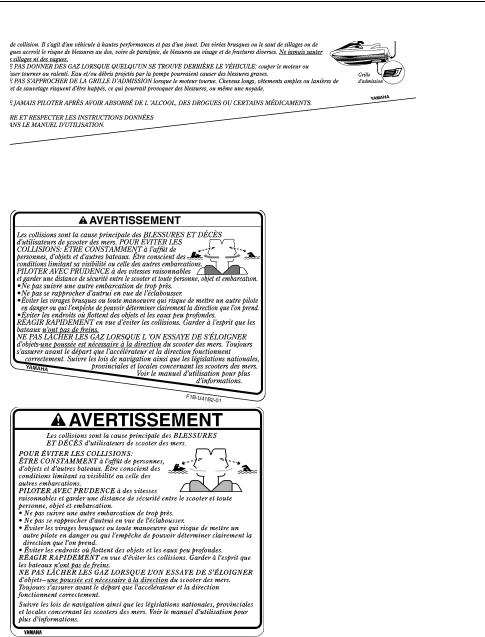
General and important labels
3
F1B-U41B1-31
F2S-U41B1-30
4
F0M-U41B2-11
6

General and important labels
5
F3J-U415B-10
F3J-U415B-30
6 |
7 |
(F1S-U41E1-11)
(F2S-U41E1-10)
(F1S-U41E1-11)
(F2S-U41E1-10)
7

General and important labels
8
F0V-U41DB-12
9
GP8-U416H-01
GJ3-U416H-01
8
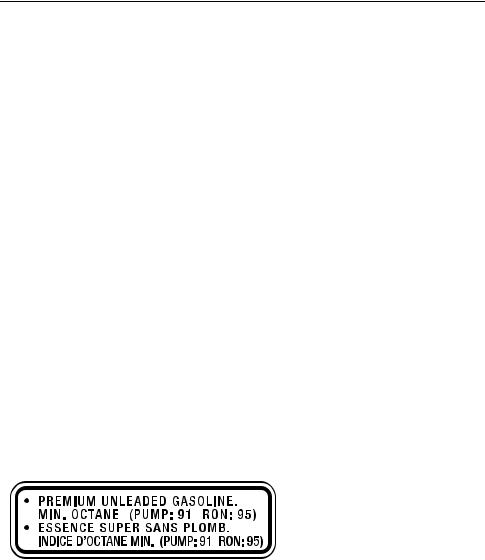
General and important labels
EJU36262
Other labels
10
F1B-U41F5-11
F1B-U41F5-21
11
(F1S-U41E1-11) (F2S-U41E1-10)
12
13
F3J-U419B-10
F3J-U419B-30
9

General and important labels
The following label indicates the correct direction to upright a capsized watercraft.
The following CE marking is located on the back of the remote control transmitter.
10

 Safety information
Safety information
EJU30683
The safe use and operation of this watercraft is dependent upon the use of proper riding techniques, as well as upon the common sense, good judgment, and expertise of the operator. Before using this watercraft, make sure that its use is permitted under local laws, bylaws, and regulations, and always operate the watercraft in full conformity with any requirements and limitations imposed. Every operator should know the following requirements before riding the watercraft.
Before operating the watercraft, read this owner’s/operator’s manual, the Riding Practice Guide, the Riding Instruction card, and all labels on the watercraft. These materials should give you an understanding of the watercraft and its operation.
Never allow anyone to operate this watercraft until they too have read this owner’s/operator’s manual, the Riding Practice Guide, the Riding Instruction card, and all labels.
EJU30742
Limitations on who may operate the watercraft
Yamaha recommends a minimum operator age of 16 years old.
Adults must supervise use by minors. Know your local operator age and training requirements.
This watercraft is designed to carry the operator and up to 2 passengers. Never exceed the maximum load limit or allow more than 3 persons (or 2 persons if a wakeboarder or water-skier is being pulled) to ride the watercraft at any time.
Maximum load: 240 kg (530 lb)
Load is the total weight of cargo, operator, and passengers.
Do not operate the watercraft with any passengers on board until you have considerable practice and experience riding alone. Operating the watercraft with passengers requires more skill. Take the time to become accustomed to the handling characteristics of the watercraft before trying any difficult maneuvers.
11
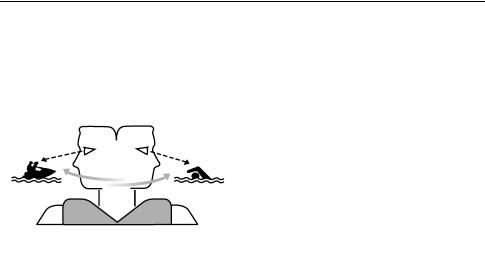
 Safety information
Safety information
EJU43321
Cruising limitations
Scan constantly for people, objects, and other watercraft. Be alert for conditions that limit your visibility or block your vision of others.
Operate defensively at safe speeds and keep a safe distance away from people, objects, and other watercraft.
Do not follow directly behind watercraft or other boats.
Do not go near others to spray or splash them with water.
Take early action to avoid collisions. Remember, watercraft and other boats do not have brakes. In addition, the Reverse with Intuitive Deceleration Electronics (RiDE) system is not a braking device for avoiding dangerous situations. The RiDE system is an electronic system for controlling the engine speed and reverse gate, which is located near the jet thrust nozzle. The RiDE lever located at the left handlebar grip can be used to change the direction of the jet thrust so that the watercraft moves in reverse or is in neutral. The RiDE system assists the operator when slowing down and during slow-speed maneuvering, such as launching, beaching, and docking.
Avoid sharp turns, slowing down rapidly by squeezing the RiDE lever forcefully, and other maneuvers that make it hard for oth-
ers to avoid you or understand where you are going.
Avoid areas with submerged objects or shallow water.
Do not release the throttle lever when trying to steer away from objects—you need throttle to steer. Always check throttle and steering controls before starting the watercraft.
Ride within your limits and avoid aggressive maneuvers to reduce the risk of loss of control, ejection, and collision.
This is a high performance boat—not a toy. Sharp turns or jumping wakes or waves can increase the risk of back/spinal injury (paralysis), facial injuries, and broken legs, ankles, and other bones. Do not jump wakes or waves.
Do not operate the watercraft in rough water, bad weather, or when visibility is poor; this may lead to an accident causing injury or death. Be alert to the possibility of adverse weather. Take note of weather forecasts and the prevailing weather conditions before setting out on your watercraft.
As with any water sport, you should not operate your watercraft without someone else nearby. If you operate further than swimming distance from shore, you should be accompanied by another boat or watercraft, but make sure you stay a safe distance away. It’s good, common sense.
Never operate in water that is less than 60 cm (2 ft) deep from the bottom of the watercraft, otherwise you increase your
12
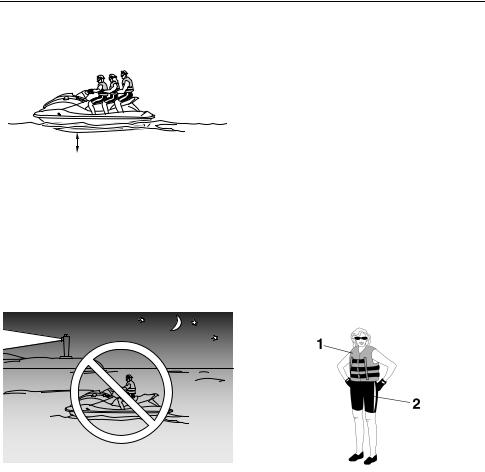
 Safety information
Safety information
chance of hitting a submerged object, which could result in injury.
60 cm (2 ft)
This watercraft is not equipped with lighting required for night operation. Do not operate the watercraft after sunset or before dawn, otherwise you increase the risk of colliding with another boat, which could result in severe injury or death.
Follow navigation rules, and state/provincial and local laws that apply to watercraft.
EJU43130
Operation requirements
All riders must wear a personal flotation device (PFD) that is approved by the appropriate authorities and is suitable for personal watercraft use.
Wear protective clothing. Severe internal injuries can occur if water is forced into body cavities as a result of falling into the water or being near the jet thrust nozzle.
Normal swimwear does not adequately protect against forceful water entry into the rectum or vagina. All riders must wear a wetsuit bottom or clothing that provides equivalent protection. Such clothing includes thick, tightly woven, sturdy and snug-fitting apparel such as denim, but does not include spandex or similar fabrics, like those used in bicycle shorts.
1 Authority-approved PFD
2 Wetsuit bottom
Eye protection is recommended to keep wind, water, and glare from the sun out of your eyes while you operate your watercraft. Restraining straps for eyewear are made which are designed to float should your eyewear fall in the water.
Footwear and gloves are recommended.
You must decide whether to wear a helmet while you ride for recreation. You should know that a helmet could help protect you
13

 Safety information
Safety information
in certain kinds of accidents and that it could injure you in others.
A helmet is designed to provide some head protection. Although helmets cannot protect against all foreseeable impacts, a helmet might reduce your injuries in a collision with a boat or other obstacle.
A helmet may have potential safety hazards, as well. Falling into the water could risk the chance of the helmet catching water, commonly known as “bucketing”, and the resulting strain on your neck could cause choking, severe and permanent neck injuries, or death. A helmet could also increase the risk of an accident if it reduces your vision or hearing, or if it distracts you or increases your fatigue.
How should you decide if a helmet’s potential safety benefits outweigh its potential risks for you? Consider your particular riding conditions. Consider factors such as your riding environment and your riding style and ability. Also consider the likelihood of traffic congestion, and the water surface conditions.
If you decide to wear a helmet based upon your riding circumstances, choose one carefully. Look for a helmet designed for personal watercraft use, if possible. If you will be engaging in closed-course competition, follow the helmet requirements of the sanctioning organization.
Never operate the watercraft after consuming alcohol or taking other drugs.
For reasons of safety and proper care of the watercraft, always perform the pre-op- eration checks listed on page 66 before operating the watercraft.
The operator should grip the handlebars firmly with both hands and the passengers should hold on firmly, either to the person
in front of them or to the handgrip provided.
The operator and passengers should always keep their feet on the floor of the footwell when the watercraft is in motion. Lifting your feet increases the chances of losing your balance, or hitting objects outside the watercraft with your feet. Do not give a ride to children if their feet cannot reach the floor of the footwell.
Never allow a passenger to ride in front of the operator.
Always consult your doctor on whether it is safe for you to ride this watercraft if you are pregnant or in poor health.
Do not attempt to modify this watercraft. Modifications to your watercraft may reduce safety and reliability, and render the watercraft unsafe or illegal for use.
Attach the engine shut-off cord (lanyard) to your left wrist and keep it free from the handlebars so that the engine stops if you, the operator, fall off. After riding, remove the engine shut-off cord (lanyard) from the wa-
14
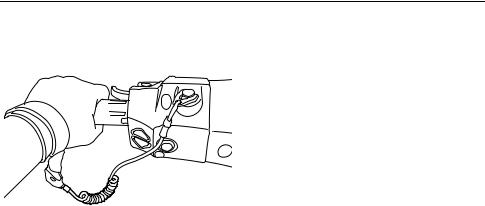
 Safety information
Safety information
tercraft to avoid accidental starting or unauthorized use by children or others.
Scan carefully for swimmers and stay away from swimming areas. Swimmers are hard to see and you could accidentally hit someone in the water.
Avoid being hit by another boat. You should always take the responsibility to watch for traffic; other boaters may not be watching for you. If they do not see you, or if you maneuver more quickly than other boaters expect, you risk a collision.
Maintain a safe distance from other boats and watercraft, and also watch for ski ropes or fishing lines. Obey the “Safe boating rules” and be sure to check behind you before making a turn or slowing down. (See “Safe boating rules” on page 19.)
EJU30841
Recommended equipment
The following items should be carried on board your watercraft:
Sound-signaling device
You should carry a whistle or other soundsignaling device that can be used to signal other boats.
Visual distress signals
It is recommended that a pyrotechnic device, which is approved by the appropriate authorities, be stored in a waterproof container on your watercraft. A mirror can also be used as an emergency signal. Contact a Yamaha dealer for more information.
Watch
A watch is helpful so you will know how long you have been operating the watercraft.
Towline
A towline can be used to tow a disabled watercraft in an emergency.
15

 Safety information
Safety information
EJU42474
Hazard information
Never start the engine or let it run for any length of time in an enclosed area. Exhaust fumes contain carbon monoxide, a colorless, odorless gas that may cause loss of consciousness and death within a short time. Always operate the watercraft in an open area.
Do not touch the hot muffler or engine during or immediately after engine operation; they can cause serious burns.
Do not place magnets or objects with a strong magnetic force near the throttle lever or RiDE lever. The electronic throttle mechanism of the levers can be adversely affected, which could cause loss of control. In addition, do not place objects susceptible to magnetic forces (i.e., credit cards, watches, etc.) close to the throttle lever or RiDE lever.
EJU42414
Watercraft characteristics
Jet thrust turns the watercraft. Releasing the throttle lever completely produces only minimum thrust. If you are traveling at speeds above trolling, you will have rapidly decreasing ability to steer without throttle. This model is equipped with the Yamaha Engine Management System (YEMS) that includes an off-throttle steering (OTS) system. It will activate at planing speeds should you attempt to steer the watercraft after releasing the throttle lever. The OTS system assists in turning by continuing to supply some thrust while the watercraft is decelerating, but you can turn more sharply if you apply throttle while turning the handlebars.
The OTS system does not function below planing speeds or when the engine is off. Once the engine slows down, the watercraft will no longer turn in response to handlebar input until you apply throttle again or you reach trolling speed.
Practice turning in an open area without obstacles until you have a good feel for this maneuver.
This watercraft is water-jet propelled. The jet pump is directly connected to the engine. This means that jet thrust will produce some movement whenever the engine is running and the “F” (forward) or “R” (reverse) shift indicator is displayed in the multifunction display. When the “N” (neutral) shift indicator is displayed, the forward and reverse thrust are balanced to help keep the watercraft from moving in either
16
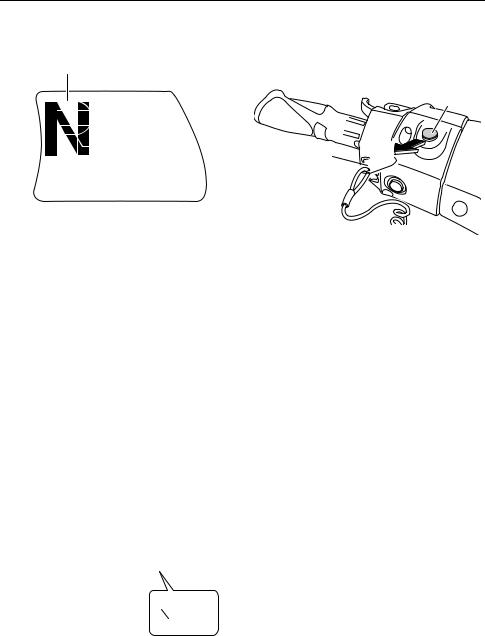
 Safety information
Safety information
direction, although some movement may occur.
1
Stop the engine and remove the clip from the engine shut-off switch before removing any debris or weeds, which may have collected around the jet intake.
2
1

1 “N” (Neutral position)
To avoid rear-end collisions while operating the watercraft, check behind you before using the RiDE lever to slow down or stop the watercraft. Make sure that there are no obstacles or people behind you before shifting into reverse.
Keep away from the intake grate while the engine is on. Items such as long hair, loose clothing, or PFD straps can become entangled in moving parts, resulting in severe injury or drowning.
Never insert any object into the jet thrust nozzle while the engine is running. Severe injury or death could result from coming in contact with the rotating parts of the jet pump.
1 Clip
2 Engine shut-off switch
 2
2
1
1 Intake grate
2 Jet thrust nozzle
17
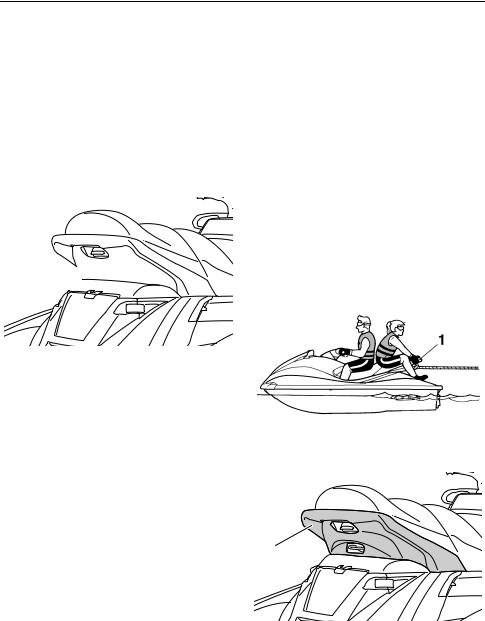
 Safety information
Safety information
EJU30956
Wakeboarding and waterskiing
You can use the watercraft for wakeboarding or water-skiing if it has the seating capacity to carry the operator, a rearward-facing spotter, and the wakeboarder or water-skier when he or she is not being pulled.
The watercraft must also have a cleat designed to pull a ski rope; do not attach the rope to any other location.
1


Normal swimwear does not adequately protect against forceful water entry into the rectum or vagina. The person being pulled should wear a wetsuit bottom or clothing that provides equivalent protection.
A second person should be on board as a spotter to watch the wakeboarder or wa- ter-skier; in many places it is required by law. Let the person being pulled direct the operator’s control of speed and direction with hand signals.
The spotter should sit astride the rear of the seat and hold onto the handgrip with both feet firmly on the floor of the footwell for proper balance while facing to the rear to watch the wakeboarder’s or water-skier’s hand signals and condition.
1 Cleat
It is the watercraft operator’s responsibility to be alert to the safety of the wakeboarder or water-skier and others. Know and follow all local regulations in effect for the waters in which you will be operating.
The operator should be comfortable carrying passengers before attempting to pull a wakeboarder or water-skier.
The following are some important considerations for minimizing risks while pulling a wakeboarder or water-skier.
The wakeboarder or water-skier should wear an approved PFD, preferably a brightly colored one so boat operators can see the person being pulled.
The wakeboarder or water-skier should wear protective clothing. Severe internal injuries can occur if water is forced into body cavities as a result of falling into the water.
1 Handgrip
1
1 Handgrip
Your control while pulling a wakeboarder or water-skier is affected by the wakeboard-
18

 Safety information
Safety information
er’s or water-skier’s ability, as well as water and weather conditions.
When preparing to pull a wakeboarder or water-skier, operate the watercraft at the slowest possible speed until the watercraft is well away from the person being pulled and slack in the ski rope is taken up. Make sure that the rope is not looped around anything.
After checking that the wakeboarder or wa- ter-skier is ready and that there is no traffic or other obstacles, apply enough throttle to raise the person.
Make smooth, wide turns. The watercraft is capable of very sharp turns, which could exceed the abilities of the wakeboarder or water-skier. Keep the person being towed at least 50 m (164 ft), about twice the distance of a standard ski rope, away from any potential hazard.
The operators of boats and other watercraft may not be aware that you are pulling a wakeboarder or water-skier. Together with the spotter, pay attention to others around you and cruise at safe speeds.
Be alert to the hazard of the ski rope handle snapping back at the watercraft when the wakeboarder or water-skier falls or is unable to get up.
Towing heavy or bulky objects other than wakeboarders or water-skiers, such as another boat or watercraft, can cause loss of steering control and create a hazardous condition. If you must tow another boat in an emergency situation, operate slowly and cautiously.
EJU30971
Safe boating rules
Your Yamaha watercraft is legally considered a powerboat. Operation of the watercraft must be in accordance with the rules and regulations governing the waterway on which it is used.
19

 Safety information
Safety information
EJU30992
Enjoy your watercraft responsibly
You share the areas you enjoy when riding your watercraft with others and with nature. So your enjoyment includes a responsibility to treat these other people, and the lands, waters, and wildlife with respect and courtesy.
Whenever and wherever you ride, think of yourself as the guest of those around you. Remember, for example, that the sound of your watercraft may be music to you, but it could be just noise to others. And the exciting splash of your wake can make waves others won’t enjoy.
Avoid riding close to shoreline homes and waterfowl nesting areas or other wildlife areas, and keep a respectful distance from fishermen, other boats, swimmers, and populated beaches. When travel in areas like these is unavoidable, ride slowly and obey all laws.
Proper maintenance is necessary to ensure that the exhaust emission and sound levels of your watercraft will continue to be within regulated limits. You have the responsibility to make sure that the recommended maintenance in this owner’s/operator’s manual is carried out.
Remember, pollution can be harmful to the environment. Do not refuel or add oil where a spill could cause damage to nature. Remove your watercraft from the water and move it away from the shoreline before refueling. Dispose of water and any fuel and oil residue in the engine compartment according to local regulations. And keep your surroundings pleasant for the people and wildlife that share the waterways: don’t litter.
When you ride responsibly, with respect and courtesy for others, you help ensure that our waterways stay open for the enjoyment of a variety of recreational opportunities.
20

Description
EJU43331
Watercraft glossary
Trolling speed
“Trolling” is the lowest maneuvering speed. You are applying little or no throttle. The watercraft is down in the water, and there is no wake.
Sub-planing speed
“Sub-planing” is a medium speed. The bow of the watercraft is slightly up from the water surface, but you are still traveling through the water. There is a wake.
Planing speed
“Planing” is a faster speed. The watercraft is more level and is skimming on top of the water. There is a wake.
Bow
The front end of the watercraft.
Stern
The rear end of the watercraft.
Starboard
The right side of the watercraft when facing forward.
Port
The left side of the watercraft when facing forward.
Bilge water
Water that has collected in the engine compartment.
Yamaha Engine Management System (YEMS)
YEMS is an integrated, computerized management system that controls and adjusts ignition timing, fuel injection, engine diagnostics, and the off-throttle steering (OTS) system.
Reverse with Intuitive Deceleration Electronics (RiDE)
RiDE is an electronic system that controls the reverse, neutral, and deceleration operations of the watercraft.
21
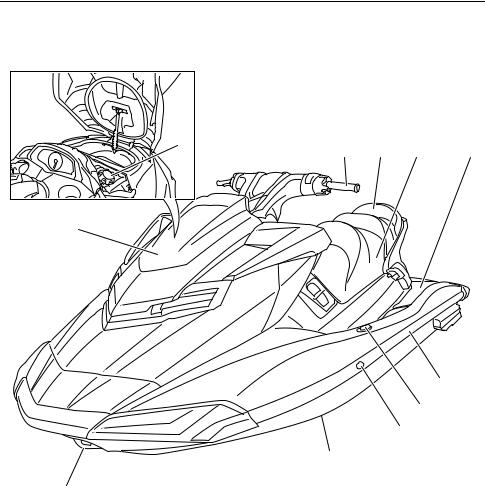
Description
EJU31012
Location of main components
Exterior
1
2
7
1 Fuel filler cap (page 59)
2 Hood
3 Handlebar
4 Rear seat (page 50)
5 Front seat (page 50)
6 Footwell
7 Bow eye (page 52)
8 Hull
9 Cooling water pilot outlet (page 31)
10Pull-up cleat (FX Cruiser SVHO) (page 53)
11Gunwale
3 |
4 |
5 |
6 |
11
10
9
8
22
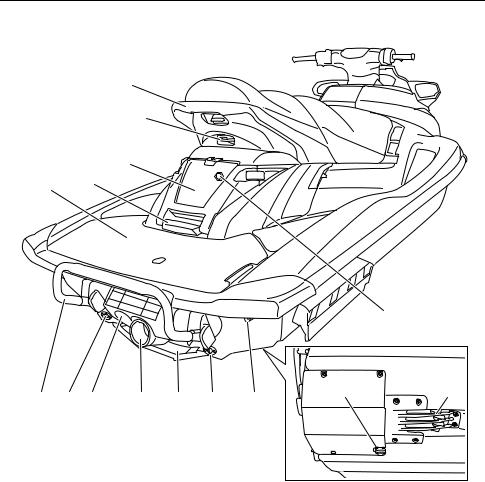
Description
5
4
3
1 2
14
12 13
6 |
7 |
8 |
9 |
10 |
7 |
11 |
1 |
Boarding platform |
13 |
Intake grate |
2 |
Reboarding grip (page 51) |
14 |
Flushing hose connector |
3 |
Stern storage compartment (page 55) |
|
|
4 |
Cleat (page 52) |
|
|
5 |
Handgrip (page 51) |
|
|
6 |
Reboarding step (page 51) |
|
|
7 |
Stern drain plug (page 63) |
|
|
8 |
Reverse gate (page 32) |
|
|
9 |
Jet thrust nozzle |
|
|
10Ride plate
11Stern eye (page 52)
12Speed sensor
23

Description
1 |
2 |
3 |
4 |
11 |
12 |
13 |
14 |
15 |
16 |
17 18 |
5
6 |
7 |
8 9 |
10 |
19 20 21 |
22 |
23 |
24 |
1 |
Built-in watertight storage compartment |
22 |
“NO-WAKE MODE” switch (page 37) |
2 |
(page 56) |
23 |
“SET” switch (page 38) |
Start switch (page 28) |
24 |
Built-in beverage holder (page 56) |
|
3 |
Engine shut-off switch (page 28) |
|
|
4 |
Clip (page 28) |
|
|
5 |
Remote control transmitter (page 26) |
|
|
6 |
RiDE lever (page 32) |
|
|
7 |
Electric trim up switch (page 34) |
|
|
8 |
Electric trim down switch (page 34) |
|
|
9 |
Engine stop switch (page 28) |
|
|
10Engine shut-off cord (lanyard) (page 28)
11“VOLT/HOUR” button (page 40)
12“SPEED/RPM” button (page 40)
13“MODE/RESET” button (page 40)
14“START/STOP” button (page 40)
15Cruise assist up switch (page 38)
16Cruise assist down switch (page 38)
17Throttle lever (page 29)
18Multifunction information center (page 40)
19Glove compartment (page 54)
20Removable beverage holder (page 56)
21Tilt lever (page 30)
24
